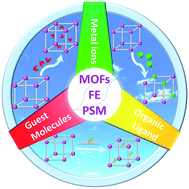Post-synthetic modification within MOFs: a valuable strategy for modulating their ferroelectric performance
Abstract
Ferroelectrics are a class of promising functional materials due to their wide applications such as transducers, capacitors, and sensors. MOF ferroelectrics, as a vital member of the ferroelectric family, have drawn considerable attention owing to their structural tunability and diversity. What is more, post-synthetic modification (PSM) of MOFs is an efficient tool to assemble the new MOFs that can present or improve the chemical and physical properties compared to the parent MOFs. Therefore, it is an attractive route to design new MOF ferroelectrics to enrich the scope of ferroelectrics or improve the ferroelectric performance to enhance the opportunity of applications through the strategies of PSM. This review discusses recent progress towards modulating the ferroelectric behaviour of MOFs through PSM, mainly involving metal-ion doping, organic ligands modifying and guest molecules tuning. All methods of PSM enhance the polarizability of the overall structure, further improving ferroelectricity. Furthermore, the challenges of MOFs ferroelectrics and feasible solutions are also described and discussed. Such a review will be beneficial to design new MOF ferroelectrics for extending the ferroelectric family and modulating ferroelectric behaviour for enhancing ferroelectricity.

- This article is part of the themed collection: 2022 Highlight article collection


 Please wait while we load your content...
Please wait while we load your content...